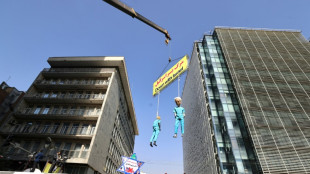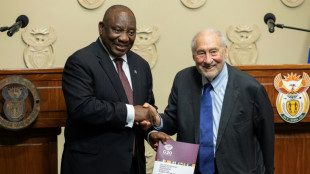
-
 Liverpool down Real Madrid in Champions League, Bayern edge PSG
Liverpool down Real Madrid in Champions League, Bayern edge PSG
-
Van Dijk tells Liverpool to keep calm and follow Arsenal's lead

-
 PSG left to sweat on injuries to Dembele and Hakimi
PSG left to sweat on injuries to Dembele and Hakimi
-
Reddit, Kick to be included in Australia's social media ban

-
 Ex-Zimbabwe cricket captain Williams treated for 'drug addiction'
Ex-Zimbabwe cricket captain Williams treated for 'drug addiction'
-
Padres ace Darvish to miss 2026 MLB season after surgery

-
 Diaz hero and villain as Bayern beat PSG in Champions League showdown
Diaz hero and villain as Bayern beat PSG in Champions League showdown
-
Liverpool master Real Madrid on Alexander-Arnold's return

-
 Van de Ven back in favour as stunning strike fuels Spurs rout
Van de Ven back in favour as stunning strike fuels Spurs rout
-
Juve held by Sporting Lisbon in stalling Champions League campaign

-
 New lawsuit alleges Spotify allows streaming fraud
New lawsuit alleges Spotify allows streaming fraud
-
Stocks mostly drop as tech rally fades

-
 LIV Golf switching to 72-hole format in 2026: official
LIV Golf switching to 72-hole format in 2026: official
-
'At home' Djokovic makes winning return in Athens

-
 Manchester City have become 'more beatable', says Dortmund's Gross
Manchester City have become 'more beatable', says Dortmund's Gross
-
Merino brace sends Arsenal past Slavia in Champions League

-
 Djokovic makes winning return in Athens
Djokovic makes winning return in Athens
-
Napoli and Eintracht Frankfurt in Champions League stalemate

-
 Arsenal's Dowman becomes youngest-ever Champions League player
Arsenal's Dowman becomes youngest-ever Champions League player
-
Cheney shaped US like no other VP. Until he didn't.

-
 Pakistan edge South Africa in tense ODI finish in Faisalabad
Pakistan edge South Africa in tense ODI finish in Faisalabad
-
Brazil's Lula urges less talk, more action at COP30 climate meet

-
 Barca's Lewandowski says his season starting now after injury struggles
Barca's Lewandowski says his season starting now after injury struggles
-
Burn urges Newcastle to show their ugly side in Bilbao clash

-
 French pair released after 3-year Iran jail ordeal
French pair released after 3-year Iran jail ordeal
-
EU scrambles to seal climate targets before COP30

-
 Getty Images largely loses lawsuit against UK AI firm
Getty Images largely loses lawsuit against UK AI firm
-
Cement maker Lafarge on trial in France over jihadist funding

-
 Sculpture of Trump strapped to a cross displayed in Switzerland
Sculpture of Trump strapped to a cross displayed in Switzerland
-
Pakistan's Rauf and Indian skipper Yadav punished over Asia Cup behaviour

-
 Libbok welcomes 'healthy' Springboks fly-half competition
Libbok welcomes 'healthy' Springboks fly-half competition
-
Reeling from earthquakes, Afghans fear coming winter

-
 Ronaldo reveals emotional retirement will come 'soon'
Ronaldo reveals emotional retirement will come 'soon'
-
Munich's surfers stunned after famed river wave vanishes

-
 Iran commemorates storming of US embassy with missile replicas, fake coffins
Iran commemorates storming of US embassy with missile replicas, fake coffins
-
Gauff sweeps Paolini aside to revitalise WTA Finals defence

-
 Shein vows to cooperate with France in probe over childlike sex dolls
Shein vows to cooperate with France in probe over childlike sex dolls
-
Young leftist Mamdani on track to win NY vote, shaking up US politics

-
 US government shutdown ties record for longest in history
US government shutdown ties record for longest in history
-
King Tut's collection displayed for first time at Egypt's grand museum

-
 Typhoon flooding kills over 40, strands thousands in central Philippines
Typhoon flooding kills over 40, strands thousands in central Philippines
-
Trent mural defaced ahead of Liverpool return

-
 Sabalenka to face Kyrgios in 'Battle of Sexes' on December 28
Sabalenka to face Kyrgios in 'Battle of Sexes' on December 28
-
Experts call for global panel to tackle 'inequality crisis'

-
 Backed by Brussels, Zelensky urges Orban to drop veto on EU bid
Backed by Brussels, Zelensky urges Orban to drop veto on EU bid
-
After ECHR ruling, Turkey opposition urges pro-Kurd leader's release

-
 Stocks drop as tech rally fades
Stocks drop as tech rally fades
-
UK far-right activist Robinson cleared of terror offence over phone access

-
 World on track to dangerous warming as emissions hit record high: UN
World on track to dangerous warming as emissions hit record high: UN
-
Nvidia, Deutsche Telekom unveil 1-bn-euro AI industrial hub


Amateur astronomers help track asteroid to French impact site
With help from amateur astronomers, scientists tracked how an asteroid travelled from space, broke up in Earth's atmosphere and sent fiery fragments shooting to the ground, gathering new information about how these space rocks disintegrate.
Asteroid 2023 CX1 briefly lit up the sky as it disintegrated over northwestern France at around 4:00 pm (1400 GMT) on February 13, 2023.
Seven hours earlier, a Hungarian astronomer had spotted the small asteroid -- which was less than a metre (yard) wide and weighed 650 kilogrammes (more than 1,400 pounds) -- roughly 200,000 kilometres (125,000 miles) from Earth.
In the following minutes and hours, scientists at NASA and the European Space Agency were able to calculate the location and timeline of its descent with unprecedented accuracy.
Observatories around the world then joined forces to study every aspect of its journey, using a range of scientific instruments.
Among those swiftly mobilising were professional and amateur astronomers from France's FRIPON/Vigie-Ciel network, which launched around a decade ago with a mission to detect and collect meteorites -- the fragments of asteroids that make it to the ground.
"We received dozens of photos and videos" of the asteroid's seconds-long journey through the atmosphere, said meteorite specialist Brigitte Zanda of France's National Museum of Natural History, which is part of the network.
Collaborating with the public -- including sifting through images posted on social media -- allowed scientists to observe the phenomenon with "unmatched precision", Zanda told AFP.
In particular, there was an "extremely useful video showing the object fragmenting, which lets us see how many pieces it broke into -- and how this happened", she said.
- 'Brutal' break-up -
The first meteorite, weighing 93 grams (3.3 ounces), was found two days later in the northwestern French commune of Saint-Pierre-le-Viger with the help of locals.
In all, around a dozen meteorites were collected and added to the museum's collection.
After two-and-a-half years, all the information gathered about the asteroid was published in a study in Nature Astronomy this week.
So far only 11 asteroids have been detected before impact -- and meteorites were only recovered from four of them, said the study.
2023 CX1 likely broke off from a larger rock in the Massalia asteroid family in the asteroid belt between Mars and Jupiter, according to the study.
As the asteroid entered our planet's atmosphere, it disintegrated "very brutally in two stages" around 28 kilometres above Earth, Zanda said.
During the process, it lost 98 percent of its mass -- and released a huge amount of energy.
"This is maybe only the second time we have observed fragmentation like this," Zanda said. "It probably depends on the speed, angle of impact and internal structure of the rock."
None of the fiery meteorites that made it to Earth damaged anything.
However simulations showed that this particular kind of fragmentation has the potential to cause more damage than a more gradual disintegration -- such as the way a much-bigger asteroid exploded over the Russian city of Chelyabinsk in 2013.
As that 20-metre-wide asteroid descended, "there were five successive fragments, each releasing a small amount of energy," Zanda said.
Still, the resulting shockwave shattered windows across the city, injuring more than 1,000 people.
J.Williams--AMWN


